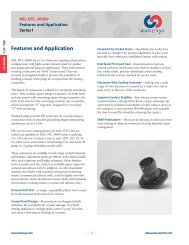Conesys - Aero-Electric Connector, Inc.
Conesys - Aero-Electric Connector, Inc.
Conesys - Aero-Electric Connector, Inc.
Create successful ePaper yourself
Turn your PDF publications into a flip-book with our unique Google optimized e-Paper software.
Performance Specifications<br />
Operating Temperature Range<br />
Classes F, K, S and BZ*: -65°C to +200°C (-85°F to +392°F)<br />
Classes W and ZC*: -65°C to +175°C (-85°F to +347°F)<br />
Material and Finish Data (Class)<br />
F – aluminum shell, electroless nickel finish<br />
K – stainless steel shell, passivated, firewall<br />
S – stainless steel shell, electrodeposited nickel, firewall<br />
W– aluminum shell, olive drab cadmium over nickel base<br />
BZ* – aluminum nickel bronze shell, std insert<br />
Z*– aluminum shell, zinc nickel finish<br />
Corrosion Resistance<br />
Classes K, W, BZ* and Z* withstand 500-hour salt spray.<br />
Classes F and S withstand 48-hour salt spray.<br />
Durability<br />
Minimum of 500 mating cycles.<br />
Fluid Resistance<br />
<strong>Connector</strong>s resist specified immersions in MIL-PRF-7808,<br />
MIL-PRF-23699, MIL-PRF-5606, M2-V Chevron oil, Coolanol<br />
25, MIL-DTL-83133 (JP-8), MIL-DTL-5624 (JP-4, JP-5),<br />
SAE-AMS1424 Type I, and other solvents and cleaning agents.<br />
Shielding Effectiveness<br />
RFI and EMI attenuation at the specified frequencies meet<br />
the requirements of MIL-DTL-38999.<br />
● RFI shielding effectiveness of mated connectors with RFI<br />
backshells is measured in a triaxial radio frequency leakage<br />
fixture.<br />
● EMI shielding effectiveness is measured at the interface<br />
of mated connectors and tested by the mode-stirred<br />
technique specified in method 3008 of MIL-STD-1344.<br />
Voltage Rating<br />
MIL-DTL-38999<br />
Performance Specifications<br />
Series III<br />
Environmental Seal<br />
Wired, mated connectors with specified accessories<br />
attached, shall meet the altitude-immersion test specified in<br />
MIL-DTL-38999.<br />
Shell-to-Shell Conductivity<br />
Maximum potential drop shall not exceed:<br />
● Classes F and S = 1.0 millivolt.<br />
● Class W = 2.5 millivolts, Class K = 10.0 millivolts<br />
Shock and Vibration Requirements<br />
Wired, mated connectors shall not be damaged, nor shall<br />
there be a current interruption longer than one microsecond<br />
when subjected to the following:<br />
Shock<br />
Pulse of approximate half sine wave of 300 G ±15 percent magnitude<br />
with duration of 3 ±1 milliseconds applied in three axes.<br />
High Impact Shock<br />
When mounted as specified in MIL-S-901, grade A, a drop<br />
of a 400 lb. Hammer from 1 foot, 3 feet and 5 feet applied to<br />
connector in three axes, totaling nine impacts.<br />
Vibration<br />
Wired and mated connectors withstand the following<br />
vibration levels:<br />
● Sine vibration where connector samples with simulated<br />
accessory load are subjected to simple harmonic motion<br />
from 10 to 2,000 Hz in three mutually perpendicular axes,<br />
in 20 minute sweeps, for 12 hours in each axis at velocity of<br />
254 mm/sec from 10-50 Hz, displacement of 1.5 mm from<br />
50-140Hz and acceleration of 60G from 140-2,000Hz.<br />
● Random Vibration per MIL-STD-1344, method 205,<br />
test condition V at ambient temperature and test<br />
condition VI, Letter “J” at elevated temperature.<br />
* Not on QPL, can be supplied to <strong>Aero</strong>-<strong>Electric</strong> part number only.<br />
Suggested Operating Voltage Test Voltage Test Voltage Test Voltage Test Voltage<br />
Service<br />
(Sea Level) Sea Level 50,000 Ft. 70,000 Ft. 100,000 Ft.<br />
Rating<br />
AC (RMS) DC V RMS V RMS V RMS V RMS<br />
M 400 550 1300 550 350 200<br />
N 300 450 1000 400 260 200<br />
I 600 850 1800 600 400 200<br />
II 900 1250 2300 800 500 200<br />
Note: The establishment of electrical safety factors is left<br />
entirely to the designer, as he is in the best position to know<br />
exactly what peak voltages, switching currents, transients, etc.,<br />
can be expected in a particular circuit.<br />
www.conesys.com – 37 –<br />
sales@aero-electric.com<br />
MIL–DTL– 38999 S III



